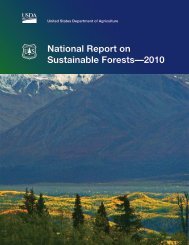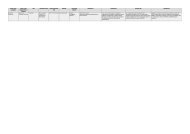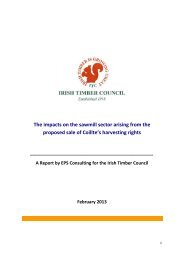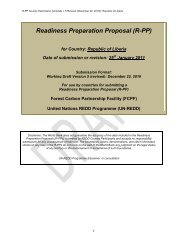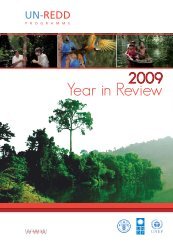pdf 1242 KByte - JIKO
pdf 1242 KByte - JIKO
pdf 1242 KByte - JIKO
Create successful ePaper yourself
Turn your PDF publications into a flip-book with our unique Google optimized e-Paper software.
Policy Paper: Assessing prerequisites for market-based REDD+ activities 24<br />
for the disbursement of REDD+ funds. With regards to efficiency, separate funds are also likely to be less<br />
bureaucratic than national funds (Spergel / Wells 2009). At the same time, however, legitimacy concerns<br />
might arise due to the fact that such a fund would sideline the country’s decision making structures (Vatn /<br />
Angelsen 2009).<br />
Another possibility is the establishing of a fund within the national state administration which would<br />
allow to channel revenues to individual projects, national programmes and sector policies. While such a solution<br />
generally receives strong support from national authorities, legitimacy granted by the private sector is,<br />
however, uncertain. In terms of effectiveness, such an architecture is expected to have positive effects on<br />
permanence.<br />
Option number four is specific budget support, where revenues flow to the national governments to support<br />
national policies. Such an architecture would receive strong support and therefore legitimacy from national<br />
leaders, while support from the private sector might be much weaker and strongly depend on the government<br />
in place. Getting It Ready! would A further Study of allow National governments Governance to Structures coordinate for REDD+ policies across sectors and give them a stronger<br />
sense of ownership and possibilities to control leakage. In terms of equity, budget support poses the possibility<br />
to integrate different goals of REDD+ and achieve co-benefits. There is however, no guarantee that such<br />
goals 4. are AN seriously OVERVIEW taken into concern OF by the THE host government OPTIONS (Vatn FOR / Vedele NATIONAL 2011). REDD+<br />
GOVERNANCE STRUCTURES<br />
Irrespective of the specific funding architecture chosen, countries would need to ensure benefits would be<br />
channelled to the local people directly affected by REDD+ activities.<br />
As emphasized in the introduction, we will evaluate four types of national governance structures<br />
Figure for REDD+; 2: Options see for Figure national 1. REDD+ funding architecture<br />
International funding<br />
(international carbon<br />
markets, global fund(s))<br />
Market directed<br />
(financial)<br />
intermediaries<br />
Separate<br />
national fund<br />
Fund in national<br />
state administration<br />
State<br />
budgets<br />
Local/private projects<br />
National<br />
programs<br />
Sector<br />
policies<br />
Project based National funds Budget support<br />
Source: Figure Vatn 1 Options and Angelsen for national (2009) REDD+ funding architecture<br />
(Reproduced from Vatn and Angelsen 2009)<br />
The market/project based system for REDD+ financing would be a system where actors – dominantly<br />
firms – with carbon emission reduction responsibilities buy reductions through funding<br />
local REDD+ projects. In principle this would be a system similar to that of today’s CDM.<br />
Certainly, voluntary payments directed at projects could also be part of such a system, going<br />
beyond the compliance or offset dimension of CDM.<br />
Nicolas Kreibich, Christof Arens and Wolfgang Sterk<br />
Wuppertal Institute<br />
The second option is a fund outside the national administration – i.e. a fund that operates<br />
independently. As in the case of existing Conservation Trust Funds, it could be led by a board<br />
consisting of both non-governmental and governmental agents. Typically, non-governmental<br />
participants would be in the majority (Spergel and Wells 2009). Such a fund or set of funds could<br />
operate through its own REDD+ programs ‘on the ground’ or through making resources available




